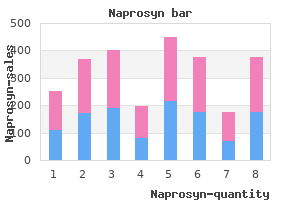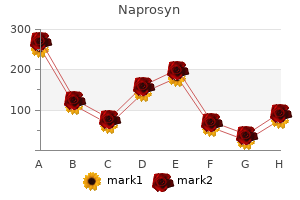"Cheap 500mg naprosyn fast delivery, rheumatoid arthritis cdc".
By: E. Hanson, M.B. B.A.O., M.B.B.Ch., Ph.D.
Medical Instructor, Boonshoft School of Medicine at Wright State University
Discount 250mg naprosyn visa
Nimatalla upright, legs pressed together, arms straight at (De Agostini collection)/Getty their sides: the forward gaze of their large Images. Images, Merchants, and Mercenaries 41 eyes, worked directly into the ivory, duplicates the rigid frontality of the bodies. Their hair hangs in neat vertical rows down their backs, its texture suggested by criss-cross patterns. Each of them wears a polos, a pillbox-style hat: some show signs of incisions around the neck which suggest that they were originally interred with a necklace of some sort. Apart from hat and jewelry, these little embodiments of ideal femininity are nude, a striking exception to the Greek ideals of the ensuing eras for the women of elite families. The proportions and clear articulation of body parts echo the local Geometric canon, and are paralleled on contemporary Attic bronzes and vases. Iron rivets, and the use of a maeander to decorate one of the poloi, signal adaptation to local taste and production by a Greek craftsman. This technique of joining was known in the Near East, but not used at this small scale. The choice suggests a concern among Greek craftsmen to conserve the costly im ported material. The material, the polos, and the nudity of these figurines, however, reflect Near Eastern origins and elite cultural value. Ivory was imported to Greece from the Near East in the Bronze Age, when it provided the materials for furniture in lays, carved boxes, and sword hilts (Hughes-Brock 1992). The prophets Amos (3:15, 6:4) and Ezekiel (27:6) railed against the excesses of those who used ivory furniture and lived in ivory houses; in Athens, the prestige of these objects would have been increased through the distance it traveled and its relative rarity (Winter 1976; Nijboer 2013). It is clear that the family who buried this woman was eager, at the point of burial, to announce their own international connectivity. Levantine analogies for the ivory females have been recovered in ivory, metal and terracotta forms. They duplicate the pose and iconography of the Dipylon figures, and even show analogous indications of necklaces. Two-dimensional representations of this figure decorate metallic horse trappings, shields, bronze bowls, jewelry and ivories found in Greek sanctuaries, imported from Syria, Phoenicia, and Cyprus. The figure type enters the Greek world along with the coroplastic techniques which were transmitted to the Greeks first on the Syro-Phoenician coast, then in Cy prus, and eventually as far west as Italy (Ammerman 1991). These are elegant, jewelry-wearing, forward-facing females, with slender waists, elaborate hair and exaggerated, naked pudenda (Riis 1948; see fig. The figures appear chiefly in 42 Sandra Blakely sanctuaries devoted to great local goddesses, including the Artemision of Ephesos, the Heraion of Samos, and the sanctuary of Hera Limenia at Perachora. The same plaques have been identified as the origin for one of the most contested el ements of religion in Southern Judah, the small, free-standing, pillar figurines whose armscradletheirpronouncedbreasts(seefig. Their low cost, find places, and great abundance has suggested a role in folk religion, though these interpreta tionsarehighlycontested.

Cheap 500mg naprosyn fast delivery
Beyond the archaeological synopsis presented above, thirty years ago Hesi geologist, Frank L. Koucky (1989), assembled the known climatic, geological, geographical, and historical data to accompany his original geomorphological survey of the Hesi region. These data had to be updated, reevaluated, and then integrated with other data sources that had not previously been tapped. The sections and paragraphs that follow forge a path towards a new understanding of the archaeological record of the Hesi region that allows it to be understood without the anomalies, or problems, now recognized. Data from Hutteroth and Abdulfattah; our map prepared by William Isenberger in association with the authors. We have to imagine a significant road connecting the two cities throughout much of the inter vening time, a road passing through the center of the Hesi region. Such a road was noted by nineteenth century explorers and was used by medieval pilgrims. It was part of the Imperial Postal Service during the fourteenth and fifteenth centuries and it was described by the Crusaders in the thirteenth century. The road was mentioned in Early Islamic times and is well known in Roman times, in part be 2 cause of the description of Eusebius and intact Roman milestones. Data from Grossman and Hutteroth and Abdulfattah plotted on the Geological Map of Israel; our map prepared by William Isenberger in association with the authors. The sites are plotted on the contemporary Map of Western Palestine (Conder and Kitchener 1880, Sheets 16, 17, 19, 20, 21, 23, 24, and 25). The dots identify ranges for the number of taxable heads of household in each village. Below, we will identify a prolonged period of good weather that promoted economic and population growth in the mid-1500s. In 1596, at the end of this period of good weather, the Ottoman Turks compiled a tax census that accounted for the growth (fig. The dots again identify ranges for the number of taxable heads of household in each village in the Gaza region. Figure 6 superimposes both data sets, but now with the geological map of Is rael as its base (Geological Survey of Israel 2001). Virtually all of the villages surround the humra and the kurkar, or are located in floodplains where Wadi el-Hesi cut through the hamra. Thus we have identified a geological unit, the Hesi region, where sedentary 3 occupation is rare, at least in the Ottoman Period. If one compares the current map from Geology of Israel with a previous effort (Picard and Salomonica 1936) you see that the units under discussion were not identified Coming to Recognize that Farming Was Rarely Practiced in Hesi 241 Fig.

Cheap 500mg naprosyn otc
It is usually a disease of child controversial because it is not clear whether strep hood. After an incubation period of 2 to 4 days, tococcal infection is the primary cause or whether there is pharyngitis, fever, chills, headache, it represents a secondary infection of preexisting malaise, vomiting, nausea, and lymphadenopathy. The disease is usually localized on the the rash, which appears 1 to 2 days after the onset gingiva and rarely in other oral areas (Fig. It first appears on the upper redness, edema of the gingiva, and patchy superfi trunk and quickly spreads within 2 to 3 days. The cial, round, or linear erosions covered with a face is infrequently involved, with few papules and white-yellowish smear. The disease is localized and rarely red, edematous, and the tongue may be covered involves the entire gingival tissues. Later, hyper submandibular lymphadenopathy are also pres trophy of the fungiform papillae follows, giving ent. The diagnosis is usually made on clinical givostomatitis and necrotizing ulcerative gin grounds. Penicillin or erythromycin is indi cated, but therapy is best left to the pediatrician. Erysipelas Erysipelas is an acute skin bacterial infection due nearly always to group A streptococci. However, in cases of facial erysipelas the redness and edema may extend to the vermilion border and the lip mucosa (Fig. Clinically, erysipelas is charac terized by a shiny, hot, edematous, bright red, and slightly elevated plaque that is sharply demarcated from the surrounding healthy skin and may show small vesicles. The differential diagnosis includes herpes zoster, angioneurotic edema, and contact dermatitis. Scarlet fever, red and edematous tongue, partially covered by a thick white coating. Bacterial Infections Oral Soft-Tissue Abscess Acute Suppurative Parotitis Acute abscess of the oral soft tissues of nondental Acute suppurative infection of the parotid glands origin is uncommon. Usually, infectious micro is usually unilateral and most frequently appears in patients more than 60 years of age, although it organism, such as Staphylococcus aureus, B-hemo-lytic Streptococcus, and rarely other microorgan may also occur during childhood. Low local or general resistance to infec infection, which may be hematogenous or spread tion is an important predisposing factor. Laboratory tests to confirm the diagnosis are the differential diagnosis includes obstructive bacterial cultures and histopathologic examina parotitis, mumps, chronic specific infections, tion.


Purchase online naprosyn
Food storage is evident especially in Room 1, a small space that contained numerous ceramic ves sels, including six storage jars. Jars used for making and storing wine were found in adjacent Room 5, and Room 4 contained several storage jars as well. Evidence for food preparation is seen in the many ground stone tools and cooking pots found throughout the house, the ovens and hearths found in Rooms 1 and 5, and the stone installation/s in Room 4. Food remains identified throughout the house include cereals, eggs, grapes, and legumes, and the bones of sheep, goat, cattle, and fish. These food remains could have entered the archaeological record through storage, prep aration, and/or consumption activities, although charred remains found in and around hearths suggest that some food was being prepared when it entered the archaeological record. Evidence for both spinning and weaving was found in Room 3 in the form of one spindle whorl, seven clay loom weights, and a bone weaving shuttle. Since the other remains found in Room 2 suggest food consumption activities, it seems that food and drink offerings were part of the cult practiced in this house. Other activities that can be inferred from remains uncovered throughout the house include metalworking and the reduction of lithic artifacts. This inti mate account of ancient daily life invites us to think about the realities of the lives of the men, women, and children who lived in settlements like Tel Halif, everyday people about whom the biblical authors wrote little. Professor Oded Borowski was one of those scholars for my research into the daily life of Iron Age Israel and Judah. Imagine my surprise when he invited me to participate in the renewed ar chaeological excavations at Tel Halif, Israel. Our mutual interests in the daily activities of the average ancient Judahite would be our focus at Tel Halif, utilizing the methodology of household archaeology. As a result of the Halif excavations, Oded has become a mentor and a friend, and it is my privilege to contribute to this volume in his honor. The study of diet, cooking, and eating practices is an effective way to understand daily life of ancient societies not only because food was essential to their physical sur vival, but also because meals are much more than just food. Meals contain a diverse collection of cultural practices embedded within them, such as dietary preferences and taboos, culinary practices, household economics, religious ritual, gender roles, power relations, and accepted social norms, just to name a few. This chapter begins with a brief survey of past and present scholarship on food studies within the research of ancient/biblical Israel and Judah, followed by 279 280 Cynthia Shafer-Elliott a description of the interdisciplinary methodology used for this present study. Focusing on one aspect of daily life, namely daily food preparation (and its assumed con sumption), will allow us to learn more about the cultural context of eighth-century Judah. Within biblical scholarship the topic of food was a concern mostly in the form of dietary laws and the sacrificial system.
Discount 250mg naprosyn visa. Rheumatoid Arthritis: The Infection Connection - Part 1.

